Update November 2018
ddlabz07
is documented in an updated hyperref PDF
ExploringDiscreteDynamics-updateJan2018.pdf which can be downloaded
HERE.
This is an updated
version of
Exploring Discrete Dynamics, Second Edition (EDD2) (2016)
published by Luniver Press,
a 8x10 inch 577 page paperback with color figures, which can be purchased at
Amazon-UK,
Amazon-USA, and other online book sellers.
November 2018 updates (on the
Jan 2018 release)
include new options for investigating "Pulsing dynamics in randomly wired glider cellular automata"
(preprint)
in 2D 3-value totalistic CA, though the options apply in general.
As well minor improvements and bug fixes, updates include:
Figures on the right are for the v3k7
Spiral‑rule.
Updates include:
- Re-randomizing the wiring at each time-step.
- If pulsing is present and the "entropy-density plot" is active,
automatically identify wave-length (wl) and wave-height (wh) can be identified automatically.
The data is output in the terminal, and can be saved.
- If the "entropy-density plot" or "density return map" is active,
sucessive dots of the scatter plot can be connected for a linked history.
- New complex "glider" rule collection are included in the updated dd_extra.tar.gz file.
- For small rule-tables expressible in decimal, consecutive rules can be
generated to classifying the entire rule-space (EDD#33.2.1).
| | | |
|
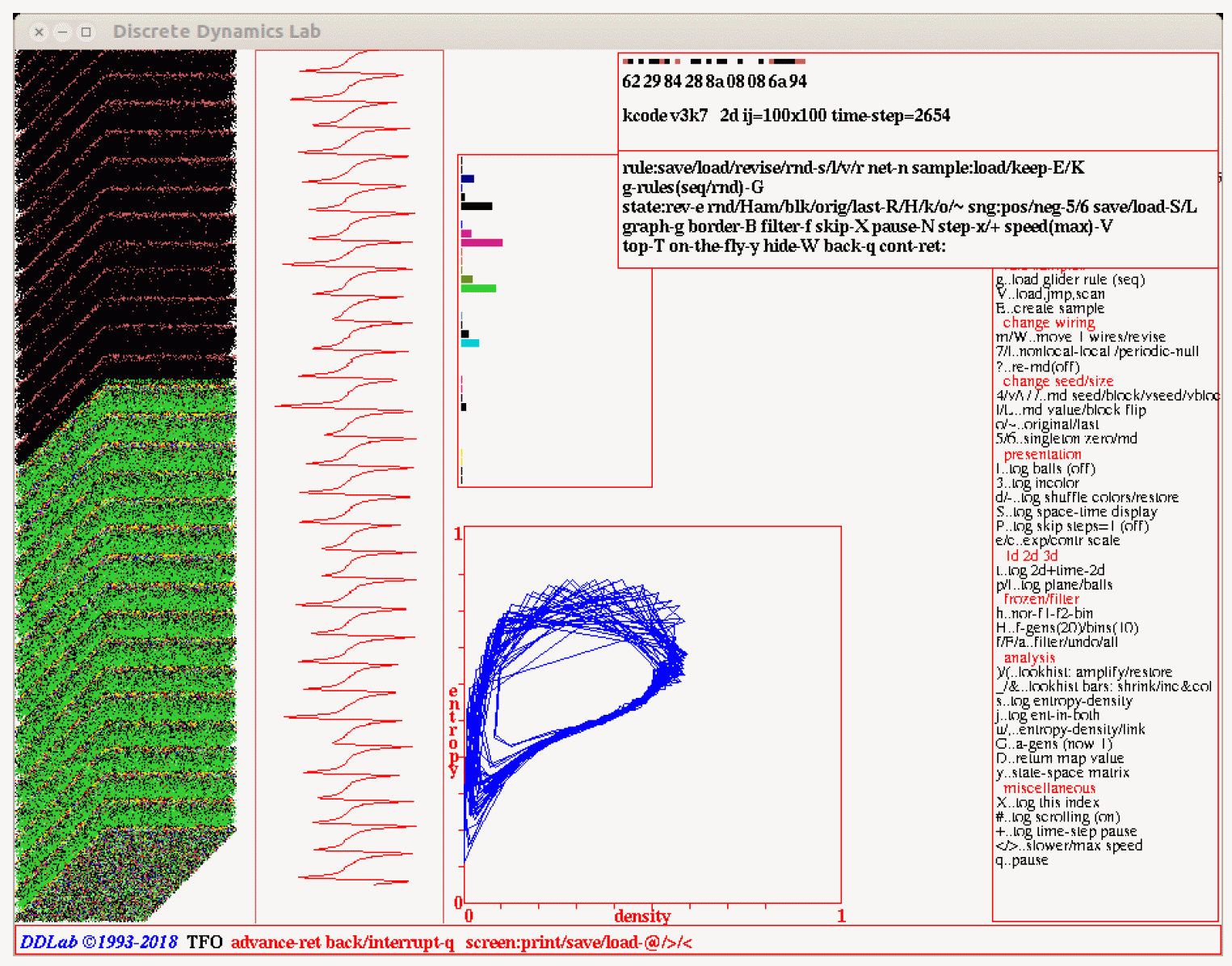
The DDLab screen showing pulsing dynamics. 2D space-time patterns, 100x100, scroll
vertically upwards on the left. The present time-step is at the bottom. The dark
time-steps at the top are colored by value, and below by neighborhood colors. To the
right of space-time patterns is the entropy plot and the input-histogram, below center
the entropy-density plot with linked dots. Interrupt prompts are shown top-right, and
on-the-fly reminder on the right. The rule is v3k7 g3 (hex) 622984288a08086a94.
| | | |
xxxxxxxxxxxxxxxxxxxxxxxxxxxxxxxxxx
DDLab has been updated at regular intervals since its release in 1995.
Its precursor was the Atlas software included on diskette
inside the back cover of
"The Global Dynamics of Cellular Automata" 1992.
For a list and download of this and older versions click
here.
(EDD2ndEd-update) is the latest documentation
Below are links to previous updates,
Jan 2018
(EDD2ndEd-update)
xMarch 2017
xxMay 2016
(EDD2ndEd)
xxxSept 2015
xxxxMay 2013
xxxxxJan 2013
xxxxxxJune 2012
(EDD)
xxxxxxxNov 2005
xxxxxxxxDec 2003
xxxxxxxxxJuly 2001
(Manual2001)
xxxxxxxxxxxFeb 1999
xxxxxxxxxxxxSept 1997
|
Download compiled versions of
ddlabz07 for Linux, Raspberry Pi, Mac, Cygwin and DOS.
The ddlabz07 source code
is available, including Makefiles, readme, GNU license, and notes.
Some of the November 2018 updates are summarised below. Click figures to enlarge.
EDD#x.x.x refers to the relevant
section in the Nov 2018 pdf update
(EDD2ndEd-update)
of the 2nd edition of Exploring Discrete Dynamics.
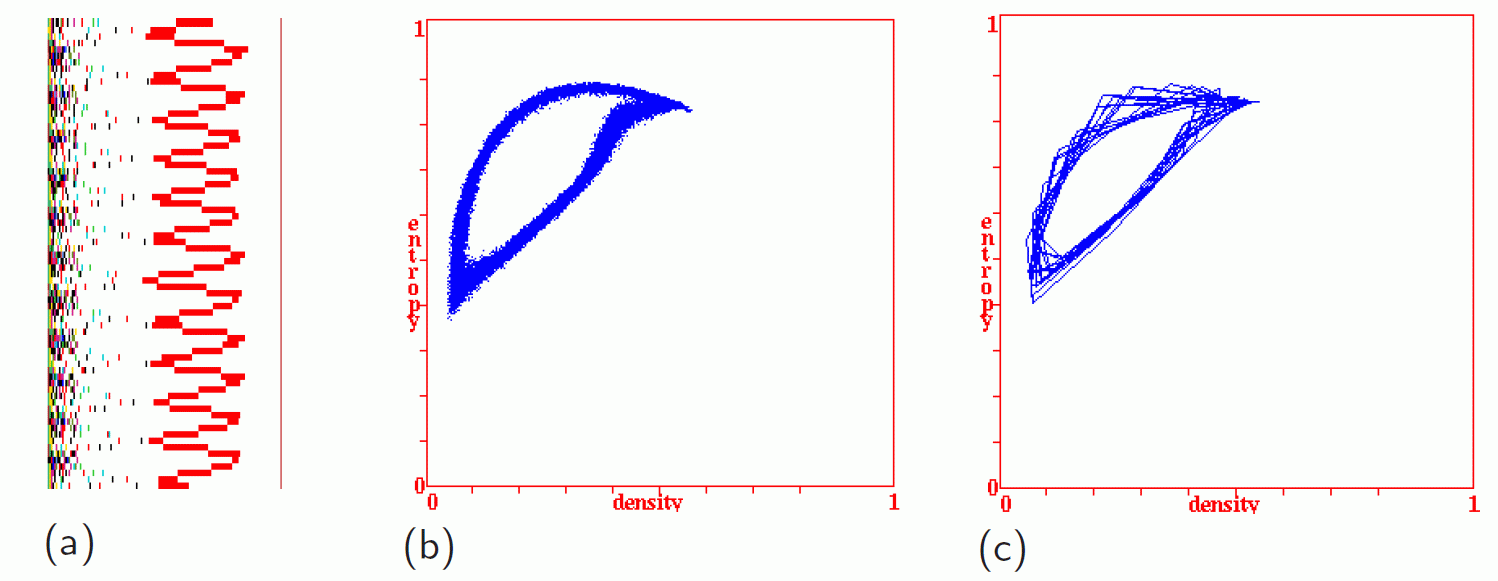
(a) Input-entropy oscillations with time, wavelength=7 time-steps,
Left edge: superimposed histogram values plots.
(b) The entropy-density scatter plot --- input-entropy (y-axis)
against the non-zero density (x-axis), for about 33000 time-steps.
(c) The same plot for just a few pulsing cycles, but linking successive dots giving a time-history.
|
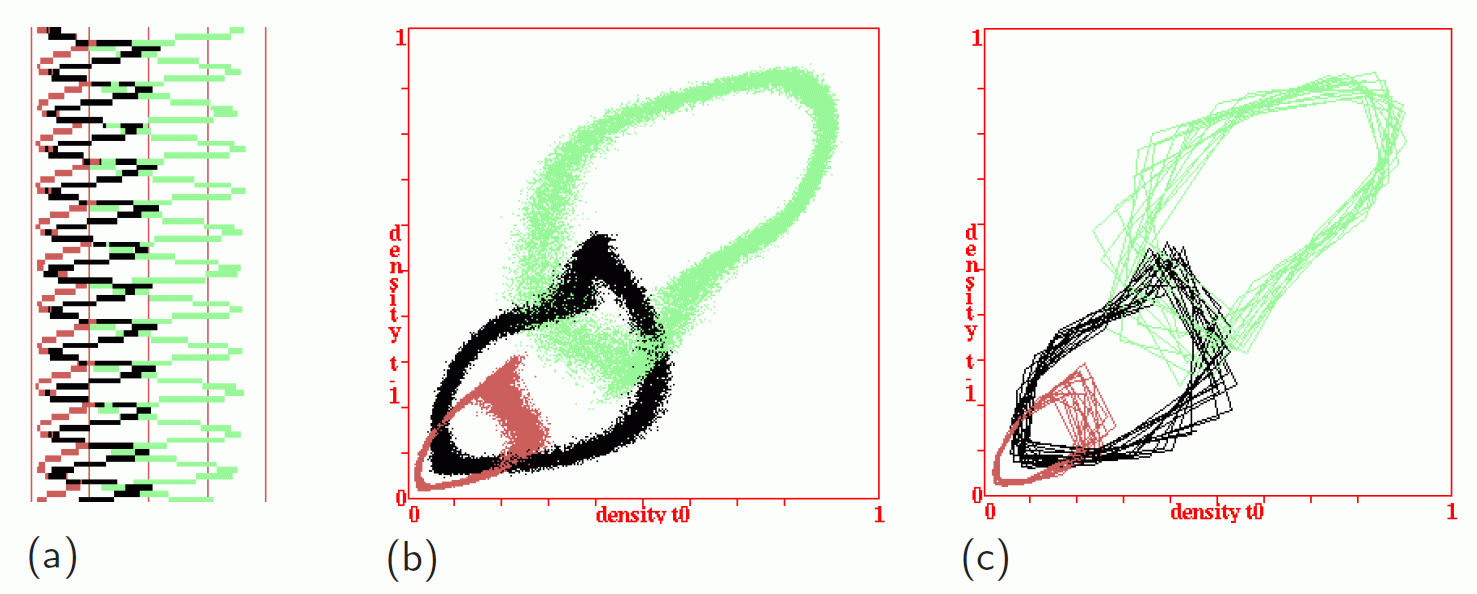
(a) Value-density oscillations with time. 0=green, 1=brown, 2=black.
(b) The density return-map scatter plot --- the density of each value at t (x-axis)
against its density at t+1, plotted as colored dots,
for about 33000 time-steps.
(c) The same plot for just a few pulsing cycles, but linking successive dots giving a time-history.
|
EDD#32.12.1 While the "entropy-density plot" or the "density return map" is active,
on-the-fly key-hit , (the coma) will toggle the connection of successive dots
of the scatter plot for a linked history, as in the examples above for the v3k7
Spiral‑rule. The linked plot
gives a much faster picture of the characteristic "strange attractor" waveform in just
a few time-steps.
|
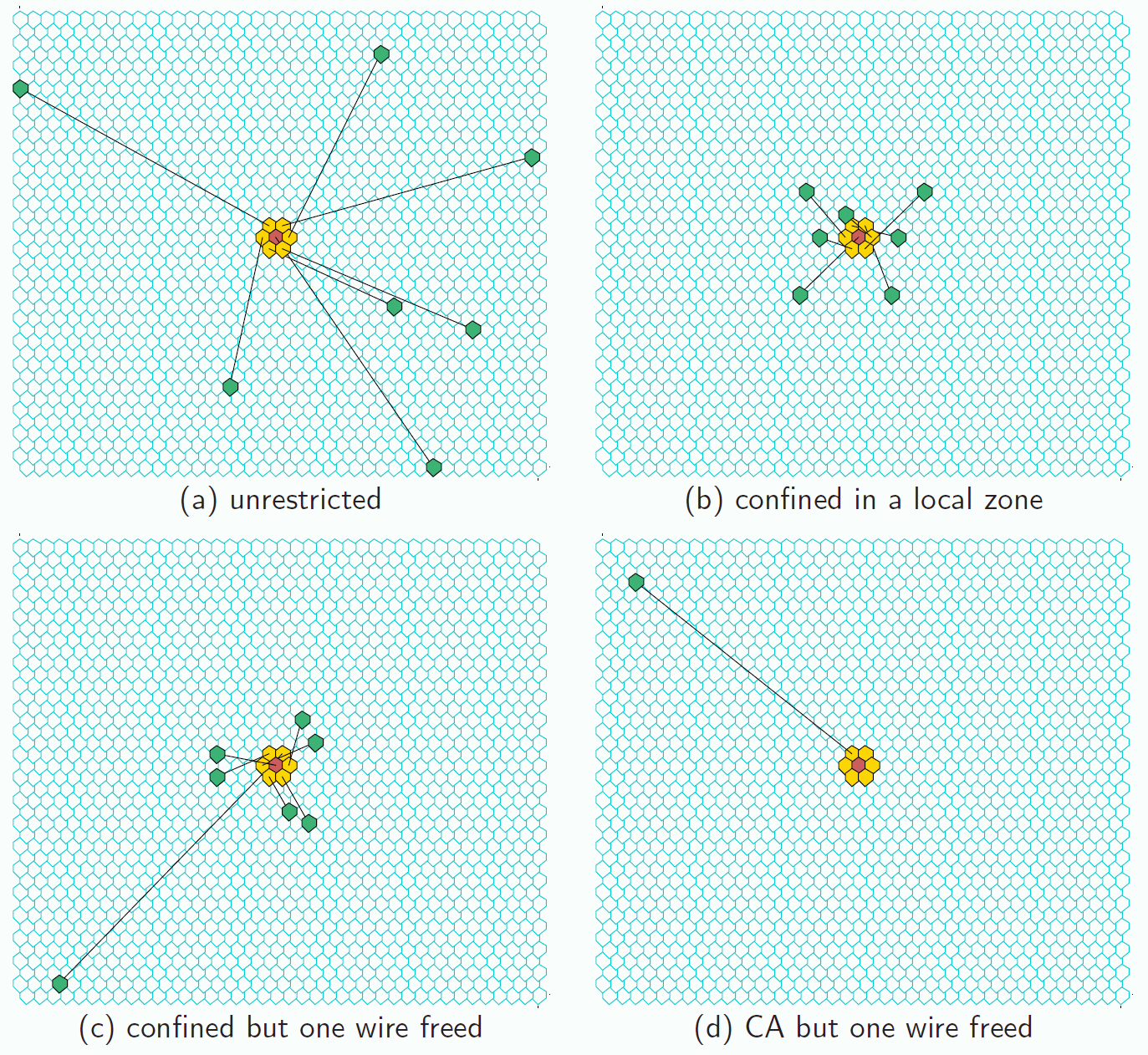
Examples of random wiring in a 40x40 2D lattice. A bigger lattice would
normally be required for robust pulsing, to avoid reaching a uniform value attractor.
| The cellular automaton pulsing model
(preprint)
described the surprising phenomenon of spontaneous, sustained and
robust rhythmic oscillations, pulsing dynamics, when random wiring
is applied to a 2D ``glider'' rule running in a 3-value totalistic CA.
The characteristic wave-forms are robust and depend
on the specific glider rule applied.
EDD#32.7.3 While running space-time patterns,
a new on-the-fly key-hit ? (question mark) allows nonlocal (random) wiring to be
re-randomised at each time-step.
The network will be re-randomised according to any random
wiring biases originally set in EDD#11 and EDD#12. It turns out that re-randomising makes no difference to the
characteristic pulsing waveform.
New complex "glider" rule collections are included in the updated dd_extra.tar.gz file.
Activate a "glider" rule with on-th-fly with keyhit g. The collections include these
2d neigborhoods for k=3 to 7.

|
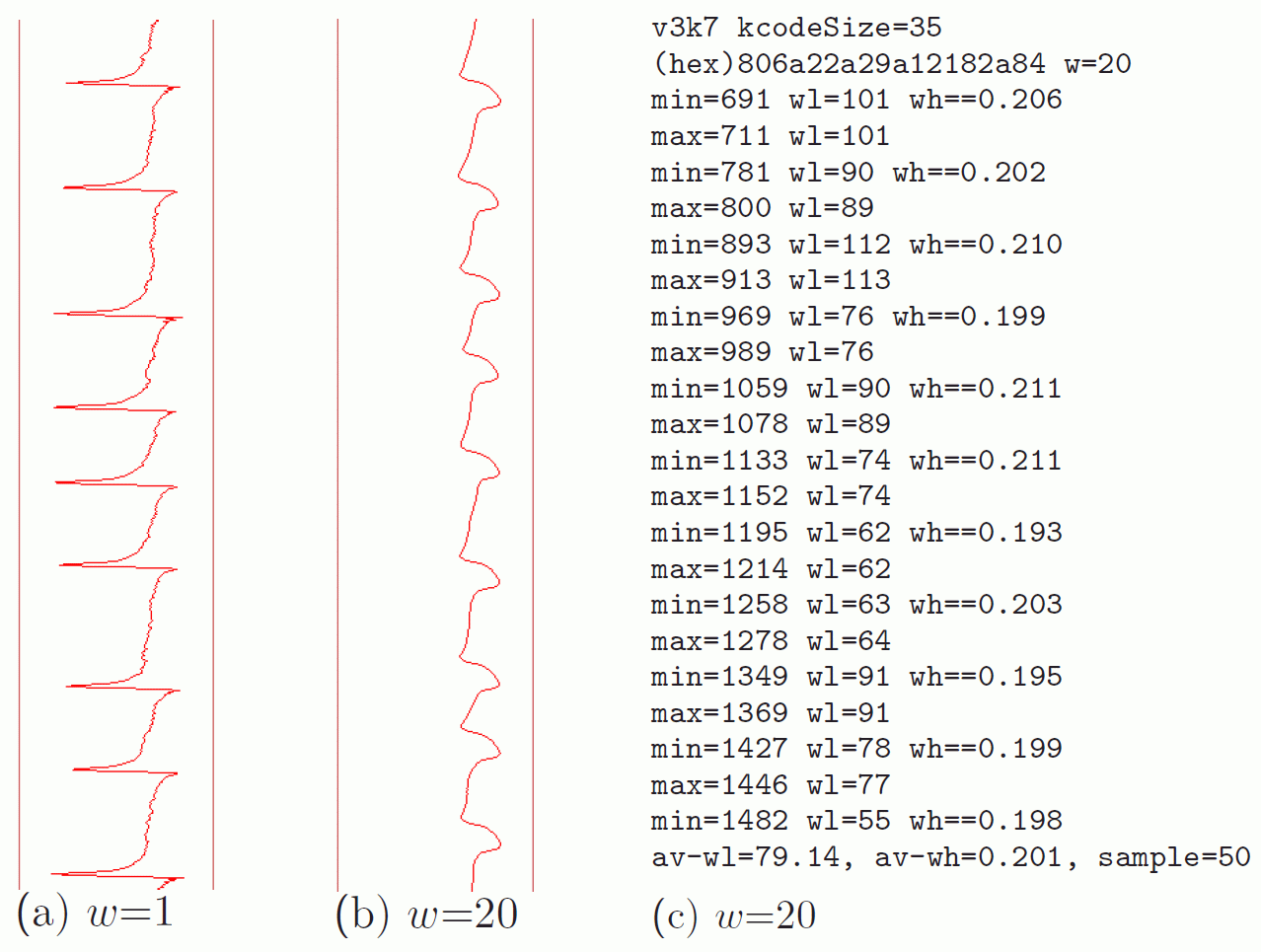
Wave-length wl for rule v3k7 g35 in \cite{Wuensche-pulsingCA},
with steady but variable wl oscillations,
and jagged stretches on the downslope of the entropy plot profile (a)
can give false min/max results, but this is fixed by
increasing the time-step window to w=20) to smooth the plot (b).
(c) shows typical data, with wl between 62 and 113 time-steps,
though the actual range is slightly greater.
The last line shows average values.
| EDD#32.12.6.2 If pulsing is present and the "entropy-density plot" is active,
a new on-the-fly key-hit " (inverted coma) will
toggle automatic data in the terminal to identify the pulsing wavelenght and waveheight.
On the left, typical data output is shown where the wave length is automatically
recognised, despite a jagged plot profile and irregular wavelength.
To save the data, interrupt with q,then enter d
for as described in EDD#32.12.6.2.
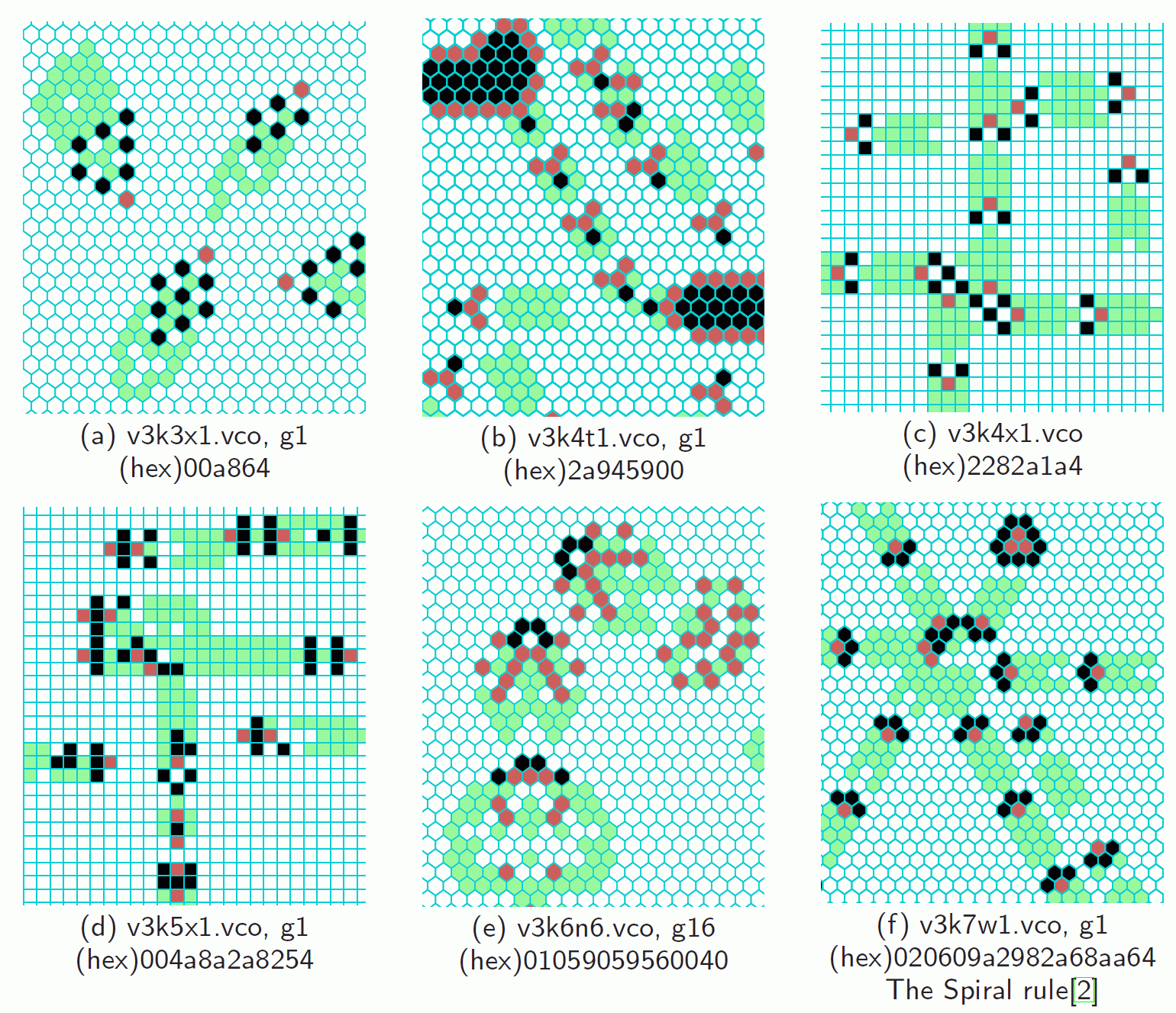
| Examples of the 2d space-time patterns of
v=3 glider rules that pulse when the local CA
wiring is randomised. These are from the "glider" rule collections,
where gx is the rule index that can be selected in EED#32.16.
Cell values: 0=white, 1=red, 2=black.
Green trails of 5 time-steps indicate glider velocity.
|
|
Return to the
Discrete Dynamics Lab home page.
Last modified: Nov 2018



